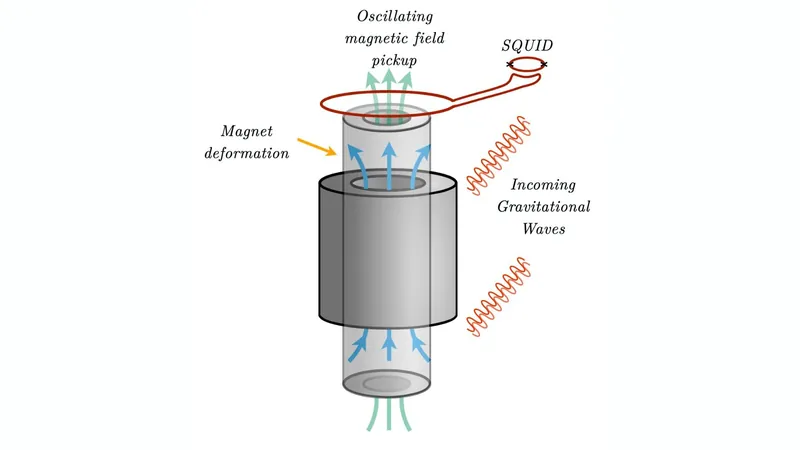
Unlocking the Universe: How Superconducting Magnets Could Revolutionize Gravitational Wave Detection
2025-06-28
Author: Wei
A Groundbreaking Leap in Gravitational Wave Detection
Exciting new research in *Physical Review Letters* reveals that superconducting magnets, typically used in dark matter detection, could be the key to detecting high-frequency gravitational waves, paving the way for a new era of cosmic observation.
Reviving an Old Concept with a Modern Twist
This innovative approach builds upon the 1960s Weber bar design, where Joseph Weber initially aimed to capture gravitational waves with massive cylinders resonating at specific frequencies. Although successful at certain points, Weber's method struggled to maintain sensitivity outside those narrow bands—until now.
Superconducting Magnets: The Future of Gravitational Wave Detection?
The latest study demonstrates that direct current (DC) superconducting magnets can act as magnetic Weber bars, potentially catching gravitational waves in the elusive kilohertz to megahertz frequency range. Dr. Sebastian Ellis from the University of Geneva spotlighted this breakthrough during a discussion, highlighting the limitations of Weber’s original design.
"Imagine an instrument that plays beautifully on key but terribly off-key," Ellis explained. This analogy underscores the new magnetic method’s ability to enhance sensitivity beyond previous constraints.
How It All Works: The Science Behind Magnetic Fields and Gravitational Waves
The detection mechanism relies on the interaction between gravitational waves and magnetic fields. As a gravitational wave vibrates through the superconducting magnet, it causes minute vibrations, similar to the subtle movements in LIGO’s mirrors. These vibrations deform the structure, generating a magnetic field that can be detected.
Remarkably sensitive quantum sensors known as SQUIDs (Superconducting Quantum Interferometric Devices) can capture these tiny fluctuations. By incorporating a pickup loop acting as a magnetic antenna, researchers can convert gravitational wave signals into electromagnetic readings with unprecedented precision.
Broadening the Search: Dark Matter Meets Gravitational Waves
The research shines a light on powerful magnets being developed for axion dark matter projects, such as DMRadio and ADMX-EFR. These state-of-the-art superconducting magnets can simultaneously hunt for dark matter while detecting gravitational waves, creating a dual-purpose scientific quest.
Ellis notes, "The vast magnetic energy of these axion experiments plays a crucial role, enabling better detection capabilities compared to traditional methods." Although the magnets’ sensitivity might be slightly less than LIGO’s peak, their broader operational range—from a few kilohertz to nearly 10 megahertz—will open new detection windows.
A New Frontier: Charting Unexplored Cosmic Waters
This new frequency range remains largely untouched in the field of gravitational wave astronomy. The idea to utilize axion experiments for gravitational wave detection emerged from recognizing their existing infrastructure could serve a dual purpose.
"By combining the search for dark matter and gravitational waves, we enhance the scientific value of these experiments," Ellis remarked.
Overcoming Challenges: The Road Ahead
Transitioning this innovative concept into a functional detection system will require navigating technical challenges, such as isolating the instruments from environmental vibrations that could mimic gravitational signals.
"Just as LIGO succeeded in isolating its devices, we remain hopeful," Ellis expressed. The research team is expanding their collaboration and is currently investigating specific gravitational wave signals that could be detected using operational magnetic Weber bars, while also exploring advanced quantum sensing techniques to further increase sensitivity.
Stay tuned, because we are on the verge of uncovering new cosmic mysteries!



 Brasil (PT)
Brasil (PT)
 Canada (EN)
Canada (EN)
 Chile (ES)
Chile (ES)
 Česko (CS)
Česko (CS)
 대한민국 (KO)
대한민국 (KO)
 España (ES)
España (ES)
 France (FR)
France (FR)
 Hong Kong (EN)
Hong Kong (EN)
 Italia (IT)
Italia (IT)
 日本 (JA)
日本 (JA)
 Magyarország (HU)
Magyarország (HU)
 Norge (NO)
Norge (NO)
 Polska (PL)
Polska (PL)
 Schweiz (DE)
Schweiz (DE)
 Singapore (EN)
Singapore (EN)
 Sverige (SV)
Sverige (SV)
 Suomi (FI)
Suomi (FI)
 Türkiye (TR)
Türkiye (TR)
 الإمارات العربية المتحدة (AR)
الإمارات العربية المتحدة (AR)